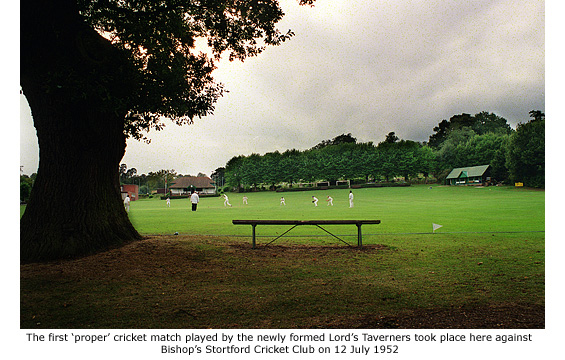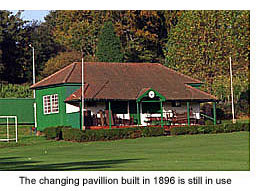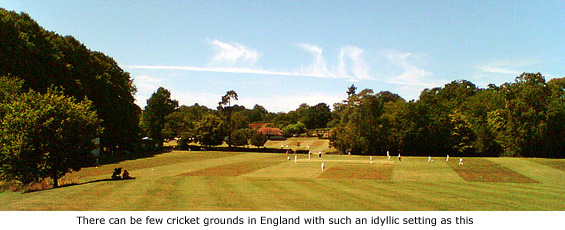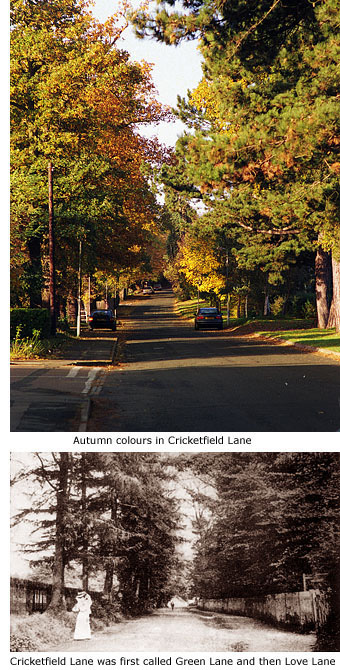|

There cannot be too many cricket clubs in England that have occupied the same ground for almost two centuries, but Bishop’s Stortford’s club in Cricketfield Lane, founded in 1825, can claim to be one of them. To put that date into perspective, the club was in existence twelve years before Queen Victoria came to the throne. The cricket ground was originally a field owned by Hawkes brewery (See Guide 6) who allowed the club to use it rent free – their only profit coming from the sale of lunch and refreshments on match days.
The laws of cricket were laid down in 1744, and in 1825 the game was still quite rudimentary – bowlers bowled round-arm and batsmen played with little or no protection. But by the 1860s the game had moved on considerably and the club became a much-respected force in Hertfordshire. The All-England XI brought several teams here during that decade to play against 22 of the town and district, and in 1868 the great W.G. Grace played on this ground for the local side as a ‘given man’, helping to secure a victory over the England XI.
 In 1877 the club was reconstituted; a new set of rules came into force and a ground rent of £50 per annum was paid. Sir Walter Gilbey accepted an invitation to become president of the club in 1895, and that same year his son, Tresham, became the new landlord – charging only £30 per year rent. The present changing pavilion was built in 1896.
In 1877 the club was reconstituted; a new set of rules came into force and a ground rent of £50 per annum was paid. Sir Walter Gilbey accepted an invitation to become president of the club in 1895, and that same year his son, Tresham, became the new landlord – charging only £30 per year rent. The present changing pavilion was built in 1896.
When Sir Walter Gilbey died in 1914, his son replaced him as president of the club. That year also saw the start of the First World War, and over the next five years the ground was used only occasionally; mainly by the Bishop’s Stortford Grammar school under the direction of its headmaster, Bruce Payne.
Perhaps the greatest event in the clubs long history came in 1928 when Tresham Gilbey handed over the Deeds of the ground to the Urban District Council. His only stipulation was that the Council should never part with the ground and that it should only ever be used for the playing of cricket.
During the Second World War the pavilions were taken over by the military, but with little time for cricket the ground became neglected. A revival came in 1946 and for this the club owed much to former England and Middlesex cricketer, E.T. Killick. Not only was he appointed Vicar of St Michael’s Church, but also a team member. The club never reached its former heights during this period but it did produce many good individual performances.
At the end of the 1960s a lack of adequate facilities put the club’s future in jeopardy and an expansion programme was started with the building of a new pavilion. Named after a former club president, Charles Edwards, it opened in 1971.
With the formation of League Cricket in 1968 and the Herfordshire Competition in 1974, the club had a number of successful seasons over the next two decades with both their first and second XI. Since 1990 they have played mainly local fixtures as well as an increasing amount of Cup cricket, and continue to play in the Hertfordshire Cricket League Premier Division. www.bishopsstortfordcc.com

|
|
The houses and cottages at this end of Barrells Down Road are all late 19th century and all have excellent views across the playing fields and cricket ground. In the early 1900s, No 136 was occupied by a Mr Newman who and ran a small bakery from land adjacent to this house – now the site of a bungalow (No 138) at the corner of Lindsey Road and Robert Wallace Close. Later taken over by his son, the bakery delivered daily to the north side of town as well as to the villages of Albury and Much Hadham, but finally closed in the mid 1950s.
A business that survived a little longer was the general store that is now No 92. It served the people of this area for many years but, like most modern day ‘corner’ shops, remaining open to be of service to very few customers wasn’t a viable option and in 1997 the owner converted the premises back to living accommodation.
To cater for population growth in the Barrells Down area in the late 19th century, a mission hall was erected here in 1898 to help with the parochial work of St Michael's church. A cottage near to the church had previously been used for the task. Funds were raised by a bazzar held in the Great Hall, South Street, and land on which to build it was given by Sir Walter Gilbey. Measuring 35ft x 18ft, with seating for 100 people, the timber-built hall cost £200 to erect and was ceremoniously opened by the Archdeacon of St Albans. In 1944 it was used as a temporary classroom for evacuees being educated at Northgate school (See Guide 7). The mission hall still stands near to the corner of Barrells Down Road and Cricketfield Lane, but now forms part of the house that is No 47.
Cricketfield Lane
 Cricketfield Lane inevitably leads to the town's cricket club, but the road's east-west direction and straightness is due to it being part of the Roman road Stane Street that linked Colchester with Braughing. Much, much later it was named Green Lane and in the 19th century Love Lane, but its current title was decided in the early 1900s. Cricketfield Lane inevitably leads to the town's cricket club, but the road's east-west direction and straightness is due to it being part of the Roman road Stane Street that linked Colchester with Braughing. Much, much later it was named Green Lane and in the 19th century Love Lane, but its current title was decided in the early 1900s.
Roads are generally named after people or places, or are descriptive of use and surroundings. With that in mind, the unusual title 'Barrells Down Road' leaves much to the imagination. However, 'Down' is also the name given to a hilly field, and 'Barrell' could well have been the surname of the field's owner. In days of old, an 's' was often added on to the end of a field name as proof of ownership, and in this case the person's name may well have been Barrell.
Adding some gravitus to this fact, first mention of the road was in churchwardens' accounts of 1550, when religious reforms forced the sale of St Michael's goods and part of the money raised from the sale went towards the ‘hyewaye against Barrels Down’. On the other hand, ‘barrells’ may well have once been rolled ‘down’ this hill, though what they contained and for what reason we’ll never know.
At the road’s junction with Rye Street is the Shell petrol station, formerly the site of Hunt’s garage and before that, stables, owned in the early 1900s by a coach proprietor named Mr Jackson who operated a hansom cab service. MORE PICTURES
|




 In 1877 the club was reconstituted; a new set of rules came into force and a ground rent of £50 per annum was paid. Sir Walter Gilbey accepted an invitation to become president of the club in 1895, and that same year his son, Tresham, became the new landlord – charging only £30 per year rent. The present changing pavilion was built in 1896.
In 1877 the club was reconstituted; a new set of rules came into force and a ground rent of £50 per annum was paid. Sir Walter Gilbey accepted an invitation to become president of the club in 1895, and that same year his son, Tresham, became the new landlord – charging only £30 per year rent. The present changing pavilion was built in 1896.
 Cricketfield Lane inevitably leads to the town's cricket club, but the road's east-west direction and straightness is due to it being part of the Roman road Stane Street that linked Colchester with Braughing. Much, much later it was named Green Lane and in the 19th century Love Lane, but its current title was decided in the early 1900s.
Cricketfield Lane inevitably leads to the town's cricket club, but the road's east-west direction and straightness is due to it being part of the Roman road Stane Street that linked Colchester with Braughing. Much, much later it was named Green Lane and in the 19th century Love Lane, but its current title was decided in the early 1900s.